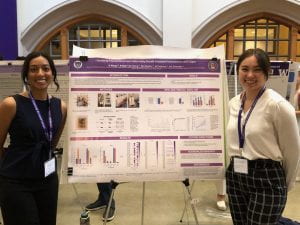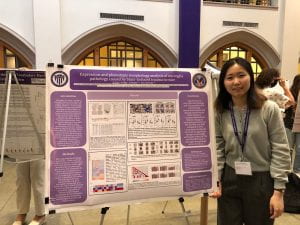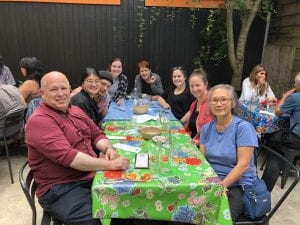Congratulations Brandon Wu and Baylee Eilers on receiving summer research fellowships from VA Puget Sound GRECC (Geriatrics Research Education and Clinical Center) and Richa Nag on receiving the UW Jeremy Clark Summer Research Fellowship! We are so excited to have you in lab full time with us this summer! Brandon with be working with Abbie on VA records research and further SIP cage developments; Baylee will be working with Monica on FMT protocols; Richa will be working with Makenzie on alcohol polytrauma interactions.
Author: aschind
Welcome Monica and Alyssa!
We are very excited to welcome Monica Tschang and Alyssa Easton to the SITlab! Monica is a graduate student in the UW Neuroscience program and her thesis will focus on targeting the gut microbiome for treatment of adverse outcomes following blast polytrauma in mice. Alyssa is a graduate student in the UW Molecular Engineering program and will be co-mentored with Dr. Sean Gibbons at Institute for Systems Biology, her thesis will focus on computational modeling of deeply phenotyped blast polytrauma mice.
Katrina, Richa, and Su present at UW Undergraduate Research Symposium



Classifying Polysubstance Use in Mice Using Socially Integrated Polysubstance (SIP) Cages
- Katrina Lee (Katrina) Wong, Senior, NeuroscienceMary Gates Scholar
- Richa Nag, Junior, Pre-Sciences
The Effect of Kappa-opioid Receptor Activation on Neural Mechanism of Blast-induced Executive Dysfunction Following Traumatic Brain Injury
- Su Gyeong (Su Cho) Cho, Senior, Neuroscience
Welcome Bryan and Ari!
The SITlab is growing! We are excited to welcome staff scientist Bryan Schuessler and rotating UW Neuroscience graduate student Ari Asarch to the lab!
New SITlab preprint! Timing matters: Sex differences in acute and chronic outcomes following repetitive blast mild traumatic brain injury
Timing matters: Sex differences in acute and chronic outcomes following repetitive blast mild traumatic brain injury
Abstract
Background Repetitive blast-related mild traumatic brain injury (mTBI) caused by exposure to high explosives is increasingly common among warfighters as well as civilians. While women have been serving in military positions with increased risk of blast exposure since 2016, there are few published reports examining sex as a biological variable in models of blast mTBI, greatly limiting diagnosis and treatment capabilities. As such, here we examined acute and chronic outcomes of repetitive blast trauma in female and male mice in relation to potential behavioral, inflammatory, microbiome, and vascular dysfunction.
Methods In this study we utilized a well-established blast overpressure model to induce repetitive (3x) blast-mTBI in both female and male mice. Acutely following repetitive exposure, we measured serum and brain cytokine levels, blood-brain barrier (BBB) disruption, fecal microbial abundance, and locomotion and anxiety-like behavior in the open field assay. Chronically, in female and male mice we assessed behavioral correlates of mTBI and PTSD-related symptoms commonly reported by Veterans with a history of blast-mTBI using the elevated zero maze, acoustic startle, and conditioned odorant aversion paradigms.
Results Repetitive blast exposure resulted in both similar and disparate patterns of acute serum and brain cytokine as well as gut microbiome changes in female and male mice. Acute BBB disruption following repetitive blast exposure was apparent in both sexes. While female and male blast mice both exhibited acute locomotor and anxiety-like deficits in the open field assay, only male mice exhibited chronic adverse behavioral outcomes.
Discussion Representing a novel survey of potential sex differences following repetitive blast trauma, our results demonstrate unique similar yet divergent patterns of blast-induced dysfunction in female vs. male mice and highlight novel targets for future diagnosis and therapeutic development.
New SITlab preprint: Socially Integrated Polysubstance (SIP) system: an open-source solution for continuous monitoring of polysubstance fluid intake in group housed mice
Socially Integrated Polysubstance (SIP) system: an open-source solution for continuous monitoring of polysubstance fluid intake in group housed mice
Abstract
Despite impressive results from neuroscience research using rodent models, there is a paucity of successful translation from preclinical findings to effective pharmacological interventions for treatment of substance use disorder (SUD) in humans. One potential reason for lack of translation from animal models is difficulty in accurately replicating the lived experience of people who use drugs. Aspects of substance use in humans that are often not modeled in animal research include but are not limited to 1) voluntary timing and frequency of substance intake, 2) social environment during substance use, and 3) access to multiple substances and multiple concentrations of each substance. Critically, existing commercial equipment that allows for social housing and voluntary polysubstance use (e.g., home cage monitoring system) is prohibitively expensive and no open-source solutions exist. With these goals in mind, here we detail development of the Socially Integrated Polysubstance (SIP) system, an open-source and lower cost solution that allows for group housed rodents to self-administer multiple substances with continuous monitoring and measurement. In our current setup, each SIP cage contains four drinking stations, and each station is equipped with a RFID sensor and sipper tube connected to a unique fluid reservoir. Using this system, we can track which animal (implanted with unique RFID transponder) visits which drinking location and the amount they drink during each visit (in 20 ul increments). Using four flavors of Kool-Aid, here we demonstrate that the SIP system is reliable and accurate with high temporal resolution for long term monitoring of substance intake and behavior tracking in a social environment. The SIP cage system is a first step towards designing an accessible and flexible rodent model of substance use that more closely resembles the experience of people who use drugs.
Mak presents at UW Alzheimers Disease Research Center Symposium
 Mak (2nd year UW Neuro Grad Program) presented her first poster as a member of the SITlab at the annual UW ADRC research symposium as part of her participation in the ADRC REC Trainee Program.
Mak (2nd year UW Neuro Grad Program) presented her first poster as a member of the SITlab at the annual UW ADRC research symposium as part of her participation in the ADRC REC Trainee Program.
“The role of the glymphatic system in the onset and development of dementia after heavy alcohol use following blast-induced mTBI”
New SITlab preprint! The Dynorphin/Kappa Opioid Receptor mediates adverse immunological and behavioral outcomes induced by repetitive blast trauma in male mice
The Dynorphin/Kappa Opioid Receptor mediates adverse immunological and behavioral outcomes induced by repetitive blast trauma in male mice
ABSTRACT
Background Adverse pathophysiological and behavioral outcomes related to mild traumatic brain injury (mTBI), posttraumatic stress disorder (PTSD), and chronic pain are common following blast exposure and contribute to decreased quality of life, but underlying mechanisms and prophylactic/treatment options remain limited. The dynorphin/kappa opioid receptor (KOR) system helps regulate behavioral and inflammatory responses to stress and injury; however, it has yet to be investigated as a potential mechanism in either humans or animals exposed to blast. We hypothesized that blast-induced KOR activation mediates adverse outcomes related to inflammation and affective behavioral response.
Methods C57Bl/6 adult male mice were singly or repeatedly exposed to either sham (anesthesia only) or blast delivered by a pneumatic shock tube. The selective KOR antagonist norBNI or vehicle (saline) was administered 72 hours prior to repetitive blast or sham exposure. Serum and brain were collected 10 minutes or 4 hours post-exposure for dynorphin and cytokine measurements, respectively. At one-month post-exposure, mice were tested in a series of behavioral assays related to adverse outcomes reported by humans with blast trauma.
Results Repetitive but not single blast exposure resulted in increased brain dynorphin level. norBNI pretreatment blocked or significantly reduced blast-induced increase in serum and brain cytokines, including IL-6, at 4 hours post exposure and aversive/anxiety-like behavioral dysfunction at one month post exposure.
Conclusions Our findings demonstrate a previously unreported role for the dynorphin/KOR system as a mediator of biochemical and behavioral dysfunction following repetitive blast exposure and highlight this system as a potential prophylactic/therapeutic treatment target.
Goodbye and good luck Janet!
Our wonderful and talented technician Janet is off to graduate school at University of Wisconsin Madison Neuroscience and Public Policy Program. Thank you Janet for your dedication and hard work, it was an absolute pleasure working together. We wish you big success at the other UW and can’t wait to catch up at a conference soon!

SITlab is hiring!
We are seeking enthusiastic scientists to join our expanding team and offer an exciting and supportive lab environment dedicated to inclusive lab culture and work-life balance. To inquire/apply: email aschind at uw dot edu.
Diversity of background and lived experience enriches research and promotes outstanding healthcare. We are committed to building and sustaining an equitable and inclusive environment. We encourage individuals whose backgrounds or interests align with this commitment, as well as individuals from all backgrounds that are historically excluded in research, to apply. Extensive training and mentorship will be provided and opportunities for career development/advancement encouraged.
Requirements: A bachelors, masters, or PhD in biological sciences and 1-6 years of research experience (preferably using rodent models and/or working with multiomic data sets). Ideal candidates should be flexible and adaptable as tasks will be varied and may change periodically and should demonstrate a desire to learn new tasks as well as to investigate and develop best practices to be shared with the study team.
Required Knowledge/Experience/Skills:
- Strong problem-solving skills and ability to multi-task and organize effectively
- Knowledge of neurobiology, pharmacology, and/or immunology
- Ability to design and execute controlled experiments
- Effective communication with internal and external researchers
- Working knowledge of statistics and reporting of research findings
Desirable Knowledge/Experience/Skills:
- Experience with rodent behavior, stereotaxic surgeries, fiber photometry, and/or voltammetry.
- Experience with cell culture, flow cytometry, immunohistochemistry, and/or immunoblotting.
- Bioinformatics including metagenomic and transcriptomic analyses.
- Experience in clinical, epidemiological, or health services research.
Salary:
We have multiple full-time positions available (1.0 FTE) ranging from GS-7 to GS-11 (DOE). The General Schedule (GS) salary table for Seattle can be found on the Office of Personnel Management website at opm.gov. Candidates must be U.S. citizens. Education and experience will be evaluated by Human Resources to determine if the top candidates meet the criteria for the targeted GS-7 to GS-11 range.
Official job posting: SITlab_RS